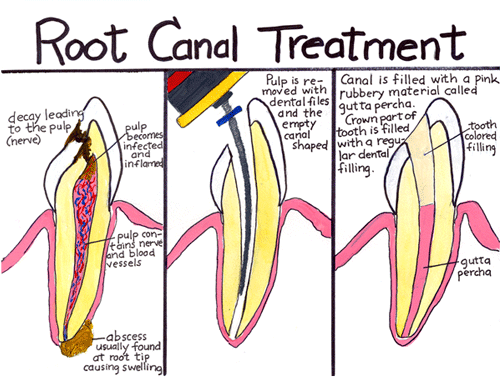Root Canal (Endodontics)
Root Canal (Endodontics)
Endodontics is the dental specialty that deals with the nerves of the teeth. Root canals are probably the most notorious procedure in dentistry and the most common procedure relating to endodontics. When a tooth becomes infected it is usually related to the nerves in the root of the tooth. The infected nerves need to be removed. If left untreated an infection can turn into an abscess, which is a much more serious problem that includes bone loss in the jaw.
The area around the tooth is numbed with a local anesthetic to start the procedure. The dentist will then drill down into the tooth to create an opening into the canal. They will then be able to remove infected tissue and clean the canal. After the infection has been removed, the space if filled with a sealant called gutta percha. It is highly recommended that a tooth that has undergone a root canal is fitted with a crown. This will improve the appearance of the tooth, and will also make it much more likely that the root canal is successful.
"Root canal" has become a scary term for dental patients to hear, but the benefits of the procedure and advances in dental technology have made it much less "scary". Local anesthetics and proper pain medication allow the procedure to be performed with little to no pain in most cases. There may be some soreness following the procedure, but that is normal for most dental procedures. Over the counter painkillers are usually enough to relieve any pain afterwards, but your dentist may prescribe medication. The procedure will also relieve you from pain caused by the infection allowing you to enjoy all the foods you love without any pain from heat, cold, or biting too hard. If you are experiencing pain consult your dentist today.
Endodontics basically means "within the tooth". Doing "endo" on a tooth means taking out the pulp of the tooth which happens to contain the nerve. It never ceases to amaze me how such a tiny nerve can cause such pain! Doing "endo" is the same as doing a "root canal".

The first step after numbing the tooth is to make an opening through the crown part of the tooth into the pulp chamber. These are fairly large in young people and get progressively calcified as we age. After cleaning out the chamber your dentist will look for the opening to each canal. Front teeth usually have only one canal. Molars almost always have three canals and sometimes four because they have more roots.
Once the canals are found they are measured for length and cleaned and shaped so they can be filled with a material called gutta percha, which is a soft rubbery material. If you have a root canal started but do not go back to get the canals filled the tooth can get reinfected because body fluids can leak back into the unfilled canals.
